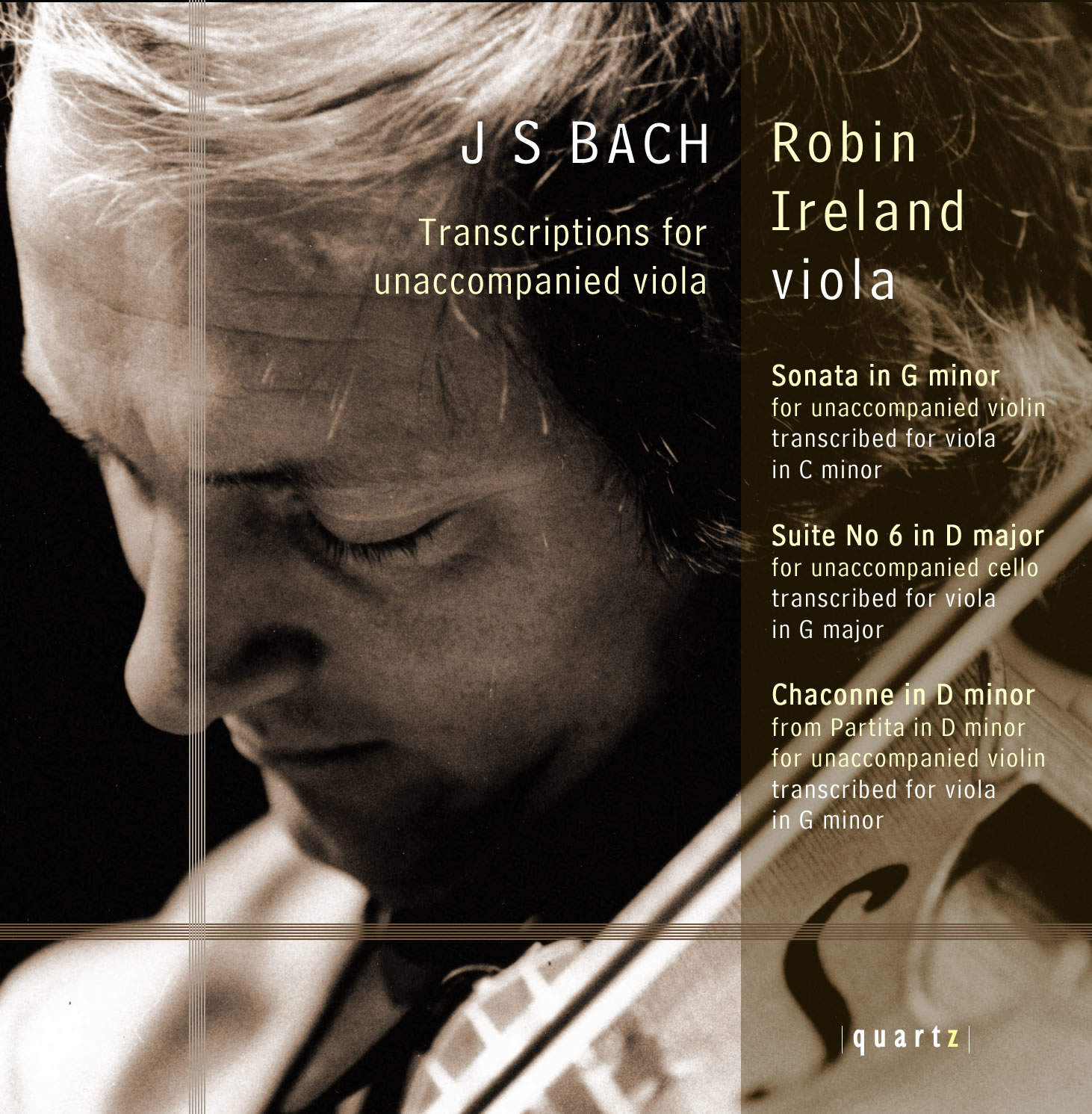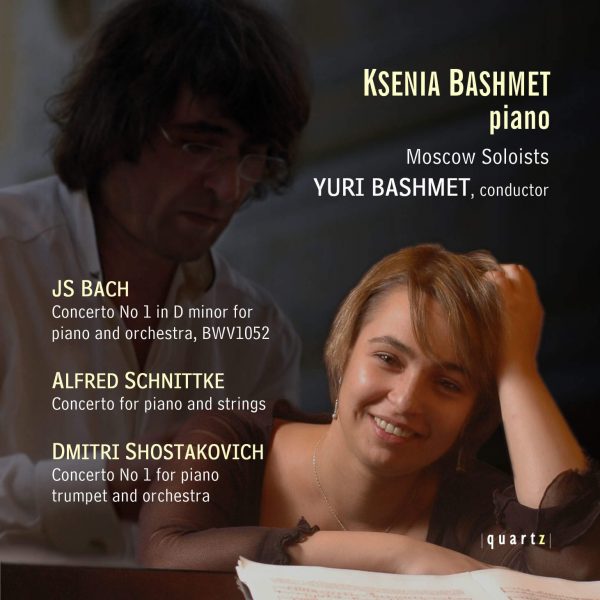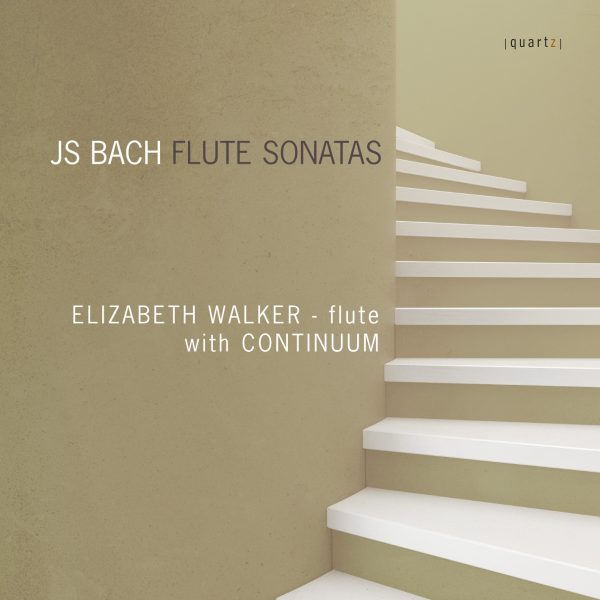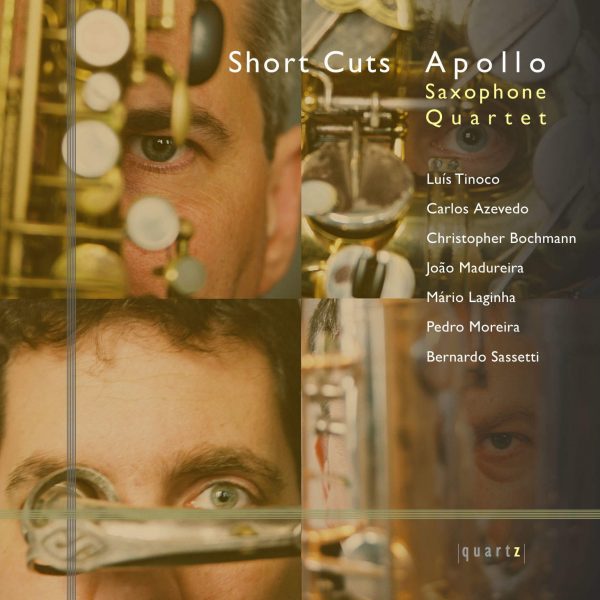J S Bach – Transcriptions for Unaccompanied Viola
£4.99 – £11.99
Sonata in G minor
for unaccompanied violin, BWV 1001
transcribed for viola in C minor
Suite No 6 in D major
for unaccompanied cello, BWV 1012
transcribed for viola in G major by Watson Forbes
Chaconne from Partita in D minor
for unaccompanied violin, BWV 1004
transcribed for viola in G minor
Robin Ireland – viola
World Premiere recordings of transcriptions for unaccompanied viola by J S Bach performed by Robin Ireland, formerly viola player with the internationally celebrated Lindsay Quartet for over 20 years.
About This Recording
Bach, the viola and transcription
Johann Sebastian Bach was the first in an illustrious line of composers who loved to play the viola. We have this from his second son, Carl Philipp Emanuel, who wrote in a letter after his father’s death, “As the greatest connoisseur and judge of harmony he enjoyed playing the viola above all”. Among those who followed him were Mozart, Dvorak and Schoenberg. In Bach’s day the viola was a quiet-spoken instrument, somewhat encumbered by its thick gut strings. It did not readily lend itself to the soloistic virtuosity that could be achieved on the violins and cellos of the period. Viola sections were often repositories of second rate violinists, and the composer and theorist Quantz felt it necessary to write that “the viola player should be at least as able as the second violinist”! The instruments themselves tended to be very large, making for uncomfortable stretches in the left hand fingering. Most 17th century violas, including the Amati I play on, were cut down to a more manageable size in the 18th or 19th century, an operation which, miraculously, seems not to have impaired their quality. The characteristics which make the viola so beloved were always there: its warmth, richness and depth of sonority and the “humanness” of its voice and expression.
Bach gave the viola its first celebrated outing as a solo instrument in the sixth Brandenburg Concerto, which is scored for two solo violas, cleverly accompanied by a pair of violas da gamba and a cello to ensure their audibility, yet written for with daring virtuosity and an obvious love for the instrument. Since Bach was extremely ready to make transcriptions of his own music, I believe he would have been delighted to hear his unaccompanied works for violin and cello played on the viola once it became more practical to do so. In transcription, different facets of the music can find emphasis through the characteristics and colours of the new instrument without compromising the music’s essence. However, the viola is not equally well suited to all the violin and cello works. The third, fourth and fifth Suites for cello are conceived with the sonority of the cello’s lowest octave as an important part of their nature, and these pieces sound shallow by comparison on the viola. The E major Partita for violin is conceived around the brilliance of the violin’s highest string, and that is also lost on the viola. However, I believe the works on this recording all lend themselves to the viola’s sound world. The dark melancholy of the Adagio which opens the G minor Sonata is perfectly expressed through the viola’s sonority, as are the passages of organ-like richness in the fugue. The Siciliana, which creates the illusion of a dialogue between a low voiced instrument and two “flutes”, is beautifully served by the viola’s bottom string, and the Presto seems to lose nothing on the viola, being less an exercise in brilliance per se than is the case with some of the fast movements in the other violin works.
The sixth Suite represents a special case since it was written for a cello with an extra string tuned a fifth higher. Played today on the four stringed cello, as is normal, it constitutes a feat of great virtuosity, beyond that of its original conception. Transcribed for the viola, to be played in G instead of D major, the extreme difficulties are avoided, and the musical realisation of the work is less endangered. This Suite does not gravitate so often to the lower regions of the cello; rather, its joyful nature seems to manifest through irrepressible buoyancy, and at times through a sustained state of suspension in an exalted realm of being. In transcription for viola, it is the relative lightness of the viola’s timbre which lends itself to the music. Anyone familiar with the original will notice some changes in register imposed by the smaller range from high to low available on the viola playing in G major, but they are surprisingly infrequent and rarely disturb the melodic line.
The Chaconne, the final movement from the Partita in D minor for violin, and unquestionably Bach’s crowning achievement for solo string instrument, has been transcribed by Schumann, Brahms and Busoni for piano, and by guitarists, cellists and probably other instrumentalists as well. It is the one movement which, like the Great Fugue from Beethoven’s String Quartet Op. 130, can stand, monumentally, on its own. I play it this way, detached from the rest, because the Partita’s fleet-footed Gigue is particularly violinistic in nature, and is not well served by the viola. The Chaconne, though, speaks along the course of its journey of tragedy, nobility, dignity, anguish, mystery, tenderness, warmth and ecstasy, all of which, to my ears, the voice of the viola wonderfully expresses. It has been a great and rewarding challenge to attempt on the viola the scaling of this musical Everest.
The Sonata in G minor (transcribed in C minor)
Dark sonority, dissonance, unexpected harmonic changes of direction and intense emotion characterise the opening Adagio, which has an almost romantic sensibility in its troubled nature. The improvisatory melodic lines invite a free and individualistic interpretation, and no two players are likely to approach it in the same way. The Fugue, almost by definition, is more detached and intellectual; it takes the seriousness of purpose of the Adagio and adds to it elements of lightness and dance. The little fugue theme serves as the kernel for a full-scale dramatic journey which explores every hidden potential for harmonisation, colour and character. The intellectual rigour of the fugal sections gives way to a more relaxed style in the intervening episodes, but these nonetheless build in tension and withhold resolution until the fugue theme finally bursts back, attaining towards the end a titanic, organ-like grandeur that appears to transcend the limits of a lone string instrument. The Siciliana, in the key of Eb on the viola, lifts and lightens the mood, bringing the music further in the direction of dance. It is eloquent, warmly expressive, and a peaceful contrast to the Fugue. The Presto completes the work in an uninterrupted stream of semiquavers which brilliantly integrates the thrill of headlong, horizontal movement with the vertical spring of dance, the simplicity of three-in-a-bar meter with unexpected rhythmic twists and turns, and intellectual rigour with playful, undemanding fun.
Suite No. 6 (transcribed in G major)
The sixth Suite is one of Bach’s celebratory affirmations of life and nature in music. It is the longest, most virtuosic of the Suites, and the familiar dance forms are stretched and developed to new proportions. The Prelude, constructed from the simplest of building blocks “ arpeggios, scales and repeated sequences “ evokes for me an image of the sea, glittering with patterns, the swell ebbing and flowing and sometimes building in great unstoppable waves. The music is static yet full of movement; it has nothing to achieve yet is full of purpose, playing the game of building suspense, withholding resolution and finally reaching its climax. The Allemande, normally the most intellectual in the sequence of dances, here sets out with a calm, meditative fluidity. It is not until well into the second half that it briefly explores more troubled waters. The Courante is nimble-footed, playful and virtuosic. The Sarabande, like the Allemande, conjures a transcendent serenity. In the Bourrees and the Gigue, feet finally make contact with the earth, although ever springing upwards. There is also a fiery flamboyance in the chordal virtuosity of the first Bourree and the acrobatic leaps of the Gigue. The second Bourree invites us briefly to a place of folk-like simplicity, with its unashamedly repetitive little dance tune and its hurdy-gurdy drone.
The Chaconne (transcribed in G minor)
The Chaconne was almost certainly composed following the sudden death of Bach’s first wife, and every listener senses the presence of an extra-musical programme in it. Brahms, in a letter to Clara Schumann, wrote, “To my mind, the Chaconne is one of the most wonderful and mysterious pieces in all music. Using a system of notes for a small instrument, the man composes a whole world of the most profound ideas and powerful feelings”. The characteristics of a chaconne are a slow, three-in-a-bar meter with an emphasis on the second beat, and a structure formed by repetitions and variations of a simple progression of chords built on a descending bass line. One of the many miracles of Bach’s Chaconne is that through such seeming limitation of the structure “a four-bar unit varied sixty-three times and always coming to rest on the same keynote“ he could fashion such a towering, continuously unfolding dramatic vision. The work surely addresses the big issues of human experience: death, suffering, and how to come to terms with them. It falls into three sections, the central one being in the major key. The first section is the largest; the opening chords, like pillars of granite, present an archetypal and public statement of tragic, defiant nobility. This huge introduction gives way to a lonely melodic voice which sets out on a private journey in which one senses that the elements of musical language are always metaphors for psychological and spiritual processes. The central section, beginning with what must be the most magical use of a simple major third in all music, is surely Bach’s vision of rebirth into a heavenly afterlife. Its tender opening grows into playfulness, celebration and finally a spiritual ecstasy. The vision disappears shockingly with the opening chord of the final section, which seems to carry the weight of the world on its shoulders, expressing an aching loss and sadness. By the end, though, a process of mourning has been completed, a true catharsis undergone; there is a renewal of strength and energy, and when the opening chords of the piece return as its completion, their defiance seems to have been transformed into a powerful statement of tragic acceptance.
Robin Ireland, 2005
Track Listing
-
J.S. Bach
- Sonata in G minor (i) Adagio
- Sonata in G minor (ii) Fugue
- Sonata in G minor (iii) Siciliana
- Sonata in G minor (iv) Presto
- Suite No 6 in D major (i) Prelude
- Suite No 6 in D major (ii) Allemande
- Suite No 6 in D major (iii) Courante
- Suite No 6 in D major (iv) Sarabande
- Suite No 6 in D major (v) Gavotte I & II
- Suite No 6 in D major (vi) Gigue
- Chaconne




